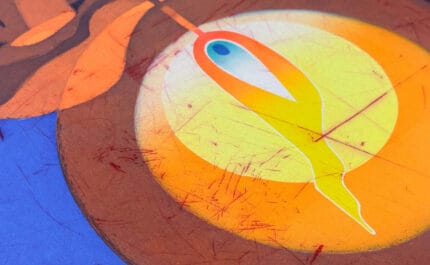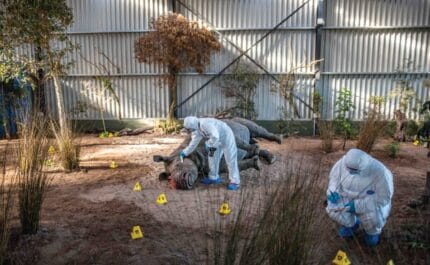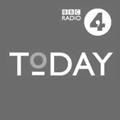Brothers in arms
The threat of Isis brutality has brought together groups of Shi’a and Sunni fighters in a controversial paramilitary force. Bob Tollast and Scott Chasserot went to Iraq to meet the Hashd al-Shaabi, Iraq’s unlikely defenders
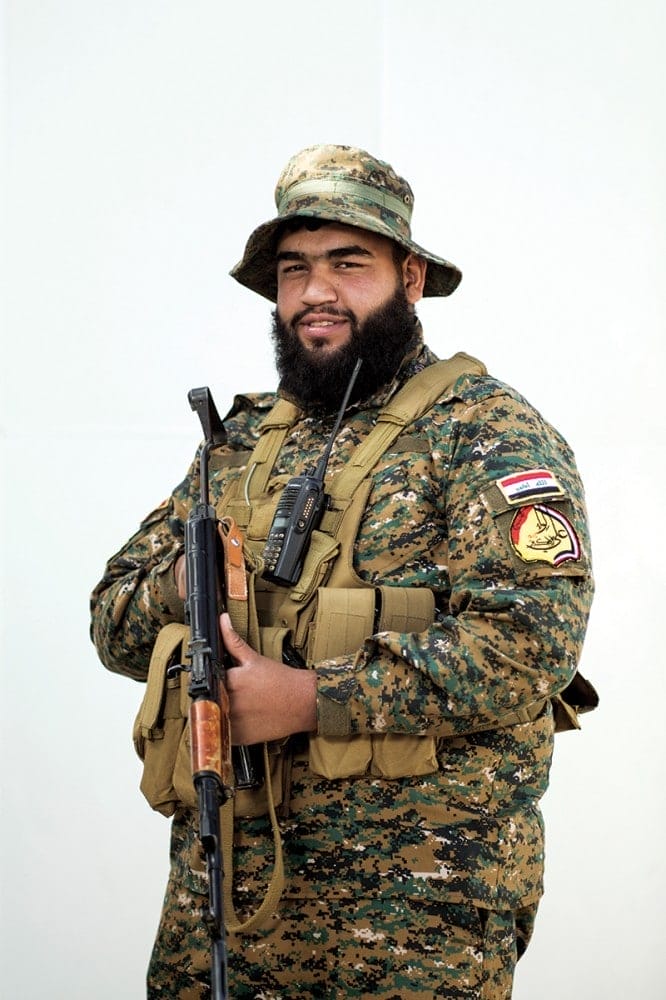
Ashraf Hassan from the Ali al-Akbar Brigade, who fought alongside pro-government Sunni tribes south of Mosul
Photography: Scott Chasserot
25th March 2016 (Taken from: #22)
We are on a dirt road in a remote part of southern Anbar, an Iraqi province partly occupied by Isis. Our vehicle – a huge SUV with tinted windows – has an automatic grenade launcher mounted on the back, and my companion, Commander Reda, is the leader of a heavily armed paramilitary force. It is a poor moment for me to pick a political fight.
But I can’t let this one go. Reda is convinced that the US wants Isis to survive, which is the reason they’ve been slow to re-commit troops to the country. I argue that this is just a conspiracy theory. He scoffs at my naivety. An uneasy silence descends on the car.
Our convoy arrives in the semi-deserted town of Nukhaib, and we step out to greet a platoon of fighters. I attempt to lighten the mood by mentioning how much we have enjoyed our trip so far in Iraq, and how we saw traditional Iraqi chobi dancing near Lake Razzaza. “Chobi?!” exclaims one of the men, laughing. “You want to see chobi?” And with that the men link arms and start chanting and hopping in a circle. It looks rather like a Morris dance, with bells and hankies replaced by grenades and Kalashnikovs.
We never called one another Sunni or Shi’a. We just had one objective, fighting for this great nation”
The men currently jigging before us are members of the Hashd al-Shaabi, a 100,000-strong force of 40 different brigades dedicated to defeating Isis. For a long time, it was far from a fair fight. These men are civilians – bakers, taxi drivers, plumbers – not trained soldiers.
Remarkably for a country with a long history of sectarian division, the Hashd – including the impromptu dance team in front of us – comprises men from both Sunni and Shi’a communities. They have been united by a shared realisation that unless they can defeat Daesh (as Isis is derisively known to many Iraqis) their country will collapse in on itself.

Ashraf Hassan from the Ali al-Akbar Brigade, who fought
alongside pro-government Sunni tribes south of Mosul
A call to arms
Over the hot and bloody summer of 2014, Isis vanquished two entire divisions of the Iraqi army and went on to capture more than a third of the country with blitzkrieg swiftness.
Before long the group that gleefully sawed off heads, extolled genocide and filmed itself drowning people (to a cheerful, chanting soundtrack) had begun to bear down on Baghdad. The Iraqi army seemed on the verge of disintegration and the US was reluctant to return to a country its troops had left three years earlier.
It was an edict from the spiritual leader of Shi’a Islam in Iraq, Grand Ayatollah Ali al-Sistani, that turned the tide. Al-Sistani’s command called on Iraq’s Shi’as to stand up and be counted, not only to defend their homes but also, crucially, to protect Iraq’s minority Sunni population.
Thousands of young Shi’a Iraqis obeyed Sistani’s fatwa and joined the newly formed “Popular Mobilisation Units” or “Hashd al-Shaabi”. Concerned that the paramilitary group would become too powerful operating independently, the Iraqi government made it an official state force, with public funding.
Ali al-Sistani’s edict to protect Sunnis was a blow to Isis. Its doctrine is a mutation of Wahhabism – a highly puritanical branch of Sunni Islam – and its mission in Iraq seemed to be to create a sectarian bloodbath, Sunni vs Shi’a. The now-deceased spiritual father of Isis, Abu Musab al-Zarqawi, wrote in 2004 that “our fighting against the Shi’a is the way to drag the Islamic nation into the battle. Someone may say that this battle will be revolting and bloody. This is exactly what we want.”

The flat terrain of Anbar provided Isis with an ideal battlefield for off-road fighting.
Now the Hashd play them at their own game with their fleets of 4x4s
In June 2014 Isis came closer than ever to their goal of setting Shi’a and Sunni at each other’s throats. At a former US army base, Camp Speicher, over 1,700 Shi’a air force cadets – many of them teenagers – were captured and machine gunned in open pits by Isis. The ruthlessness of the slaughter recalled the massacres of Shi’as carried out by Saddam Hussein’s Baathist Republican Guard in 1991, following a failed Shi’a uprising against Saddam’s Sunni-led dictatorship. Many of Iraq’s 200 mass graves are thought to date back to that time. Was history repeating itself? Certainly, Iraq’s dark history of Sunni-Shi’a division did not look promising for national unity.
But then something extraordinary happened. In small towns in Diyala and Anbar, places that for years were zones of lawlessness and terrorism, small bands of Sunni fighters resisting Isis reached out to the Hashd forces who had filled the void of the retreating Iraqi army. In the face of a well organised and ruthless enemy, handshake alliances were struck and resources pooled. Rather than dividing the denominations, Isis had united them.
In one famous case in September 2014, a ragtag band of Sunni fighters in the small village of Dhuluiyah approached a unit of the Hashd for help. The Sunni villagers were low on ammunition and about to be surrounded by Isis. Overcoming their differences, the two sides joined forces, a move the Washington Post called “a marriage of convenience”. Eighteen months later, it’s a development that seems not only to have lasted, but expanded across Iraq.
My enemy’s enemy
The Ali al-Akbar Brigade is a group of around 5,000 Hashd with more than 1,000 Sunni members. Before our trip to the impromptu Chobi dancers of Nukhaib, we visited their HQ in what used to be the offices of a bus company on the road to Najaf. Sleeping mats and blankets filled the corners of cavernous rooms and men in combat fatigues milled around, waiting for their call to join the front line.
Ashraf Hassan, a Shi’a fighter with Ali al-Akbar, had no concerns about fighting alongside Sunnis. “Sunnis on the approach to Shirqat [a village near Mosul] were fighting with us, in one front line – we were mixed up,” he said. Hassan is a friendly bear of a man who was wounded by an Isis car bomb, and later took mortar shrapnel to his back. “We lived together for over six months in Baiji and never called one another Sunni or Shi’a. We just had one objective, fighting for this great nation.”
For all the swagger of the Hashd, the remarkable thing that comes across is how much of a civilian army it remains. The Ali al-Akbar Brigade’s logistics operations, for example, generally involve filling cars with bread and water and driving to the front.
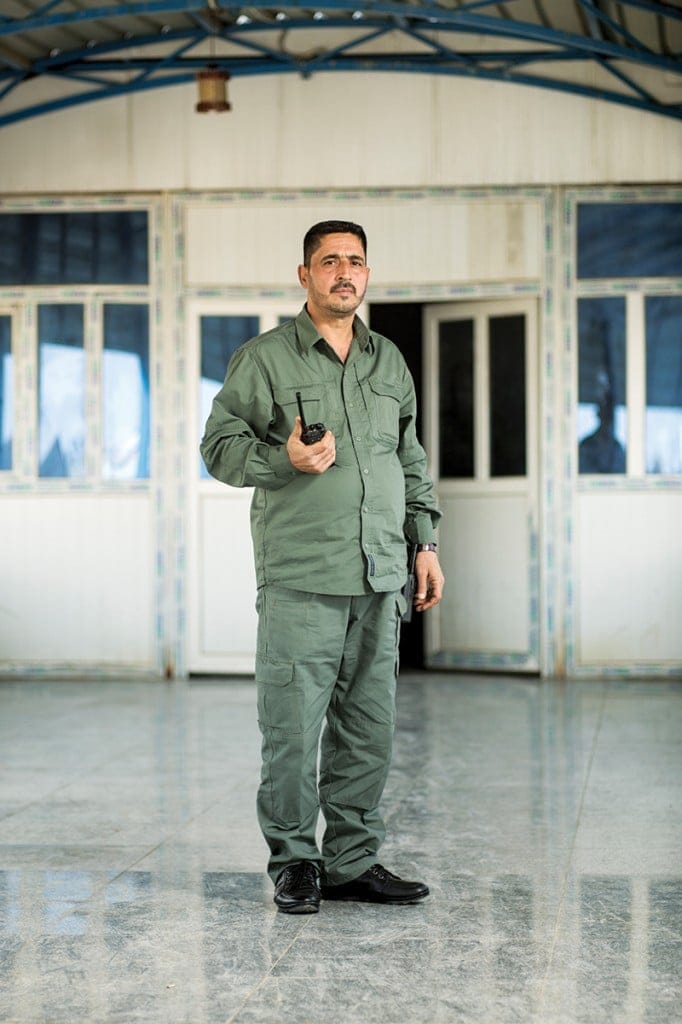
Abbas, a baker from Karbala who closed his businesses to join the Hashd al-Shaabi,
lost his son on a logistics mission
Abbas, who was a baker before the Isis offensive, still looks very much like a baker now. He took part in the first major Hashd victory in Jurf al-Sakhar in late 2014. The Iraqi army had been trying and failing to clear the area of Isis for months, and Abbas helped to supply the Hashd groups that finally did the job. “We could actually get to Jurf with bread that was still warm and sometimes we’d make two or three trips a day, back and forth,” he said. The fact that Abbas could get bread to Jurf while it was still warm is a reminder how close Isis got to Shi’a majority towns in 2014. Had they been able to enter these areas in large numbers, a repeat of the Speicher massacre would have been likely.
Abbas has put his life on hold during the fighting. “I own two shops but I have closed them since the jihad call. I have to serve these men fighting for my country,” he told us. His role took on a deeper meaning after an IED attack hit their convoy. “My son was 17 years old,” he said. “After he was martyred, we redoubled our efforts. We will never give up.”
I own two shops but I have closed them since the jihad call. I have to serve these men fighting for my country”
Perhaps it is the commitment against the common enemy of men like Abbas that has helped Sunnis to stand with them. Certainly, at no point did we feel like we were in the presence of a divided platoon. These men were more like a motley band of brothers.
But while the civilian nature of the Hashd is still visible, after a series of bruising battles and heavy casualties in 2014, the organisation appears to have adapted to the methods of Isis. A part of this comes from the Darwinian nature of going to war; there’s no training like actual combat, as long as you survive. Tactics improved: several fighters we spoke to said that after Isis used armoured vehicles as suicide car bombs, rocket launchers were placed at checkpoints. And the Hashd’s weaponry has improved too: Iraqi government funds, boosted by Iranian aid, have allowed for an influx of long-range sniper rifles. At the same time, thousands of coalition airstrikes have made it difficult for Isis to travel in large numbers on the roads.
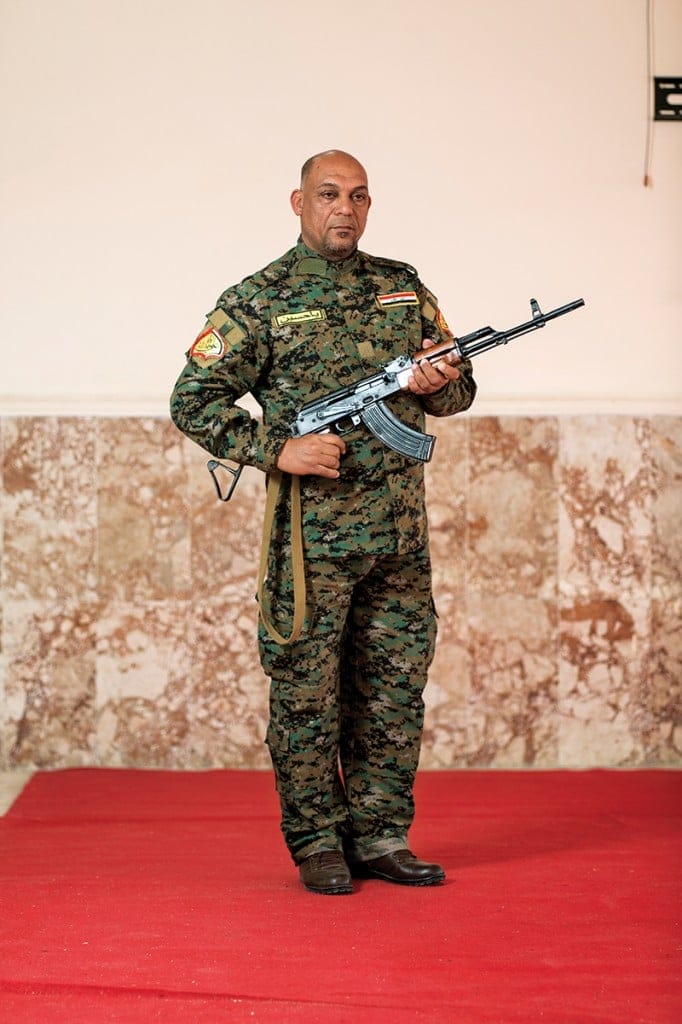
Commander Kassem Mosleh of the 5,000-strong Ali al-Akbar Brigade.
Mosleh is confident that Isis will be defeated in 2016
As Isis numbers have been depleted, the sheer size of the Hashd, combined with the remnants of the Iraqi army, means that Isis has little hope of countering numerical odds which are often greater than 10-1. It’s a simple tactic that would probably seem inefficient and unscientific to US commanders who fought al-Qaeda in Iraq during the occupation. But flooding an area with fighters seems to work.
To the Ali al-Akbar commander Kassem Mosleh, there is another weapon in their arsenal that is less tangible. “Our strongest weapon is faith, which has led us to take ground from Isis. Isis is breathing its last breath, it is on the verge of collapse. As for the sectarian divide in Hashd, this is a false media narrative.”
The Sunni Hashd
After the spontaneous dance routine comes to an end in Nukhaib, we enter a large, chilly house. There is little evidence of family life here: home comforts have been replaced with satellite maps and AKs lean against the walls.
Here we meet Omar and Yousif, two middle-aged Sunni fighters of the Abbas Combat Division, a unit of around 3,000 Hashd who are chiefly loyal to Ayatollah Ali al-Sistani. Both men were among a group of several hundred Sunnis who fled their homes with their families as Isis swept across central Anbar. They settled in the small town of Nukhaib where, before long, a Hashd garrison was established.
Isis is breathing its last breath, it is on the verge of collapse. As for the sectarian divide, this is a false media narrative”
Omar is at first reluctant to talk, simply telling us he was “just a taxi driver” before the war with Isis. He still has family in areas under Isis control, in his home town near Fallujah. Last year Isis kidnapped his cousin, who had married a Shi’a woman. Omar does not think he will see him alive again.
It was in this time of upheaval that Omar and Yousif’s families received food aid and blankets from the Abbas Division, a move that was the essence of modern “hearts and minds” warfare. “We love to be in the Hashd,” says Yousif, who comes from al-Qaim, a border town now under Isis control. “We never received any help from anyone when Daesh came. We had nowhere to go, we had no shelter. The Abbas Division opened the door to us, we were recruited here and we are together with family members.”
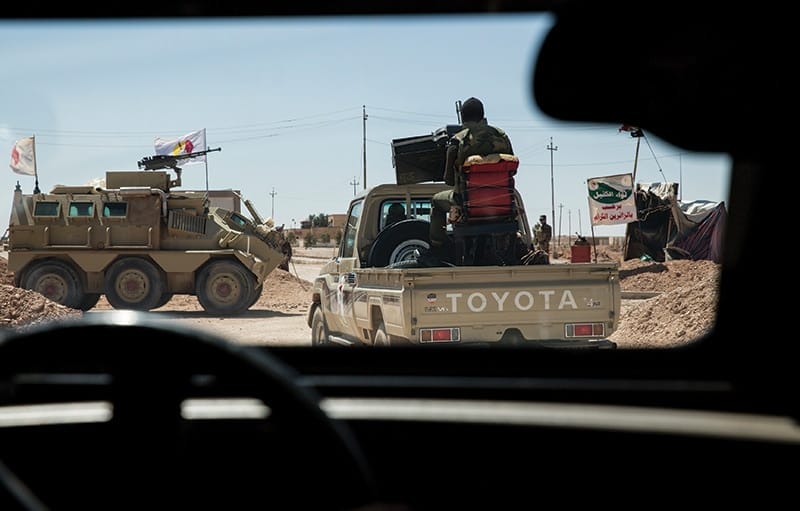
The Hashd al-Shaabi’s equipment comes from all over the world. The 6×6 military vehicle guarding this checkpoint is a French-made Panhard VCR armoured personnel carrier
Omar recalls the havoc of 2014. “My town fell under Daesh control straight away,” he says. “At first, some of the sheikhs agreed because they were so opposed to [Iraq’s former Prime Minister Nouri] al-Maliki. After three days, strangers entered our town. They started beheading people. It was a time of chaos, there were a lot of gun battles, you didn’t know who was fighting who. They forced us to be with them, otherwise…” He tails off, perhaps afraid to contemplate the fate of family members who were left behind.
I ask why Omar thinks Sunnis have joined the Shi’a in fighting Daesh, after such a long and tumultuous history between the two communities. “Daesh blew up our houses,” he says. “We have no homes, we have no crops, they have destroyed everything. We want them out.” Several commanders in the Hashd told us that while their Sunni allies had a fervent hatred for Daesh, they also brought more than just extra manpower. Local knowledge proved vital, helping find suspects and navigate Iraq’s mazes of hamlets, canals and palm groves.
It seems that an end may be in sight to the nightmare endured by Omar, Yousif and their friends. In April 2016, news came through that a major offensive was close to retaking the town of al-Hit in Anbar, less than an hour’s drive from al-Qaim. More reports suggested Isis were running out of funds and manpower. If a 60-nation coalition wasn’t enough to stop them, then the turning of Iraq’s Sunnis against them may well spell the doom of the outnumbered group.
As we finished our small cups of sugary black tea, and prepared to leave the office of the Abbas Division, I wondered if Yousif has a message for the world. “My message to society, especially Sunnis, is that when we lost our homes, nobody welcomed us but the Shi’a,” he says. “We joined up, we went to the front with the Shi’as, there is no difference. Only the uneducated minds support Daesh.”
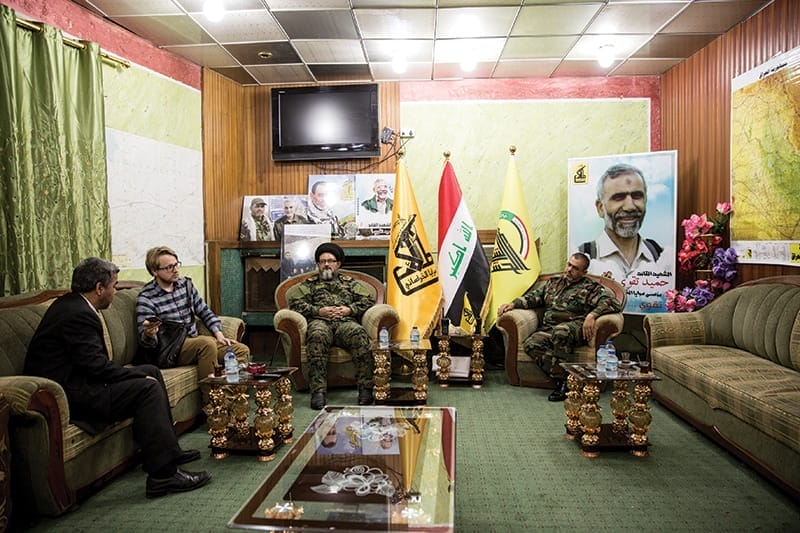
Commander Ali al-Yaseri of Saraya al-Khorasani (far right) is accompanied by deputy commander Hamid al-Jazaeiri for our interview. Pictures of Iranian generals including Hamid Taghavi (large poster on right) and Qassem Suleimani adorn the walls
Endgame
It has taken a common enemy to bring together Shi’as and Sunnis in the Hashd, but what if – as seems increasingly likely – Isis falls? Can the fighters go back to being bakers, taxi drivers, bystanders? If they can’t, it remains to be seen whether in the long run the Iraqi government – and the US – can overlook the strong ties that certain brigades have to Iran.
The mixed loyalty of some Hashd groups is in plain view when we meet Ali al-Yaseri, head of the Saraya al-Khorasani brigade in Baghdad. His office is adorned with a huge poster of Iranian general Qassem Suleimani. “The Shi’a have seen life under a strict dictatorship, torture, the killing of thousands of people…” says al-Yaseri. “Sunnis are scared of revenge when we come to their towns.” However, even al-Yaseri has seen divisions bridged within his ranks. He keenly recounts the story of a Sunni fighter from Saladin, the province that contains Saddam’s home town of Tikrit. “We had a Sunni martyr, his sister was kidnapped and used as a slave. His soul is still with us, he fought without even body armour on the front line, and he became a symbol to us, of bravery fighting Daesh.”
We joined up, we went to the front with the Shi’as, there is no difference. Only the uneducated minds support Daesh”
It will take more than a shared victory to overcome centuries of division, violence and revenge. And Iraq is facing more problems than just Isis: after the oil price collapse, the government is broke, and Hashd salaries are now under threat. Government over-spending has left the state short of $2.5 billion a month. Meanwhile, in April, the Sadrists (a political group often seen to represent Iraq’s poorest Shi’as) stormed parliament with thousands of protesters. The protests were a reaction to corruption in Iraq, and ended peacefully – this time. The Sadrists have their own Hashd group, and some fear the next war in Iraq may be among different Hashd factions, or will see the Hashd separating out along sectarian lines.
Whatever happens, it is hard to think of the Sunnis and Shi’as who joined arms in dance in Nukhaib ever turning on each other. Nonetheless, the defeat of Isis may bring yet greater challenges to this delicately balanced band of brothers.
Slow Journalism in your inbox, plus infographics, offers and more: sign up for the free DG newsletter. Sign me up
Thanks for signing up.
